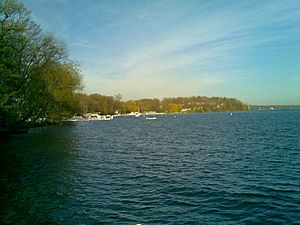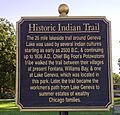Geneva Lake facts for kids
Quick facts for kids Geneva Lake |
|
|---|---|
 |
|
| Location | Walworth County, Wisconsin, United States |
| Coordinates | 42°33′54.04″N 88°30′13.50″W / 42.5650111°N 88.5037500°W |
| Primary outflows | White River |
| Basin countries | United States |
| Max. length | 12 km (7.5 mi) |
| Surface area | 5,401 acres (8.439 sq mi; 21.86 km2) |
| Average depth | 61 feet (19 m) |
| Max. depth | 135 feet (41 m) |
| Settlements | Lake Geneva, Fontana-on-Geneva-Lake, Williams Bay |
Geneva Lake is a beautiful freshwater lake in southeastern Wisconsin, located in Walworth County. Along its shores are the city of Lake Geneva and the villages of Fontana-on-Geneva-Lake and Williams Bay.
This lake is famous for something very special: it's the only place in the world where mail jumping happens! This is a unique way of delivering mail that has become a local tradition.
Geneva Lake covers about 5,401 acres (21.86 km²). It stretches for about 7.5 miles (12 km). The lake is about 61 feet (19 m) deep on average. Its deepest point reaches 135 feet (41 m). Scientists believe the lake formed from a melting glacier. It filled a bowl-shaped hole in the ground called a kettle.
Contents
Exploring Geneva Lake's Shoreline
The lake and the nearby city of Lake Geneva got their names from a town in New York. This town, called Geneva, is on Seneca Lake. An early surveyor, John Brink, thought the Wisconsin area looked similar. To avoid confusion with another town in Illinois, the city was named Lake Geneva. Later, the lake itself became known as Geneva Lake.
Fun Places to Visit Around the Lake
There are many interesting spots along the shore of Geneva Lake. These include:
- Big Foot Beach State Park: A great place for outdoor activities.
- Lake Geneva Yacht Club: Where you can see many boats and sailing events.
- Aurora University's George Williams College campus: A beautiful college campus.
- Yerkes Observatory: A historic place for looking at stars. The University of Chicago used to own it. In 2020, a group called the Yerkes Future Foundation took over.
The Public Shorepath: A Walk Around the Lake
You can walk all the way around Geneva Lake! This is thanks to an old rule from the first European settlers. They decided that 20 feet (6 meters) of land leading to the shoreline should be open to everyone.
This public path completely circles the lake. It is between 21 and 26 miles (34 and 42 km) long. The path follows an old route once used by the Potawatomi Indians. As you walk, you'll pass by the large estates of famous families. These include the Schwinns (known for bicycles), Swifts, Wackers, and Wrigleys.
Images for kids







